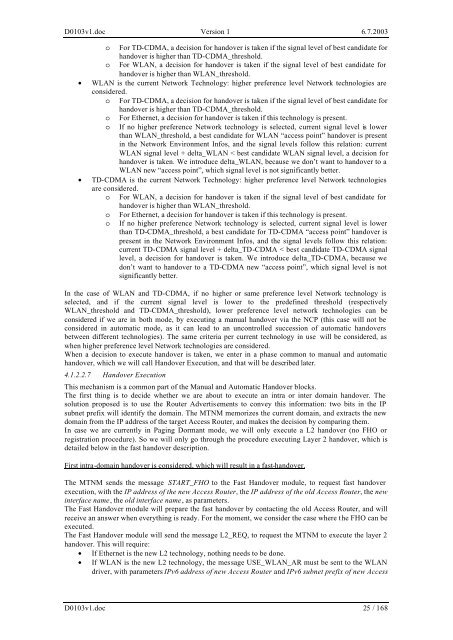Moby Dick Consolidated System Integration Plan
Moby Dick Consolidated System Integration Plan
Moby Dick Consolidated System Integration Plan
Create successful ePaper yourself
Turn your PDF publications into a flip-book with our unique Google optimized e-Paper software.
D0103v1.doc Version 1 6.7.2003<br />
o For TD-CDMA, a decision for handover is taken if the signal level of best candidate for<br />
handover is higher than TD-CDMA_threshold.<br />
o For WLAN, a decision for handover is taken if the signal level of best candidate for<br />
handover is higher than WLAN_threshold.<br />
• WLAN is the current Network Technology: higher preference level Network technologies are<br />
considered.<br />
o For TD-CDMA, a decision for handover is taken if the signal level of best candidate for<br />
handover is higher than TD-CDMA_threshold.<br />
o For Ethernet, a decision for handover is taken if this technology is present.<br />
o If no higher preference Network technology is selected, current signal level is lower<br />
than WLAN_threshold, a best candidate for WLAN “access point” handover is present<br />
in the Network Environment Infos, and the signal levels follow this relation: current<br />
WLAN signal level + delta_WLAN < best candidate WLAN signal level, a decision for<br />
handover is taken. We introduce delta_WLAN, because we don’t want to handover to a<br />
WLAN new “access point”, which signal level is not significantly better.<br />
• TD-CDMA is the current Network Technology: higher preference level Network technologies<br />
are considered.<br />
o For WLAN, a decision for handover is taken if the signal level of best candidate for<br />
handover is higher than WLAN_threshold.<br />
o For Ethernet, a decision for handover is taken if this technology is present.<br />
o If no higher preference Network technology is selected, current signal level is lower<br />
than TD-CDMA_threshold, a best candidate for TD-CDMA “access point” handover is<br />
present in the Network Environment Infos, and the signal levels follow this relation:<br />
current TD-CDMA signal level + delta_TD-CDMA < best candidate TD-CDMA signal<br />
level, a decision for handover is taken. We introduce delta_TD-CDMA, because we<br />
don’t want to handover to a TD-CDMA new “access point”, which signal level is not<br />
significantly better.<br />
In the case of WLAN and TD-CDMA, if no higher or same preference level Network technology is<br />
selected, and if the current signal level is lower to the predefined threshold (respectively<br />
WLAN_threshold and TD-CDMA_threshold), lower preference level network technologies can be<br />
considered if we are in both mode, by executing a manual handover via the NCP (this case will not be<br />
considered in automatic mode, as it can lead to an uncontrolled succession of automatic handovers<br />
between different technologies). The same criteria per current technology in use will be considered, as<br />
when higher preference level Network technologies are considered.<br />
When a decision to execute handover is taken, we enter in a phase common to manual and automatic<br />
handover, which we will call Handover Execution, and that will be described later.<br />
4.1.2.2.7 Handover Execution<br />
This mechanism is a common part of the Manual and Automatic Handover blocks.<br />
The first thing is to decide whether we are about to execute an intra or inter domain handover. The<br />
solution proposed is to use the Router Advertisements to convey this information: two bits in the IP<br />
subnet prefix will identify the domain. The MTNM memorizes the current domain, and extracts the new<br />
domain from the IP address of the target Access Router, and makes the decision by comparing them.<br />
In case we are currently in Paging Dormant mode, we will only execute a L2 handover (no FHO or<br />
registration procedure). So we will only go through the procedure executing Layer 2 handover, which is<br />
detailed below in the fast handover description.<br />
First intra-domain handover is considered, which will result in a fast-handover.<br />
The MTNM sends the message START_FHO to the Fast Handover module, to request fast handover<br />
execution, with the IP address of the new Access Router, the IP address of the old Access Router, the new<br />
interface name, the old interface name, as parameters.<br />
The Fast Handover module will prepare the fast handover by contacting the old Access Router, and will<br />
receive an answer when everything is ready. For the moment, we consider the case where the FHO can be<br />
executed.<br />
The Fast Handover module will send the message L2_REQ, to request the MTNM to execute the layer 2<br />
handover. This will require:<br />
• If Ethernet is the new L2 technology, nothing needs to be done.<br />
• If WLAN is the new L2 technology, the message USE_WLAN_AR must be sent to the WLAN<br />
driver, with parameters IPv6 address of new Access Router and IPv6 subnet prefix of new Access<br />
D0103v1.doc 25 / 168
















